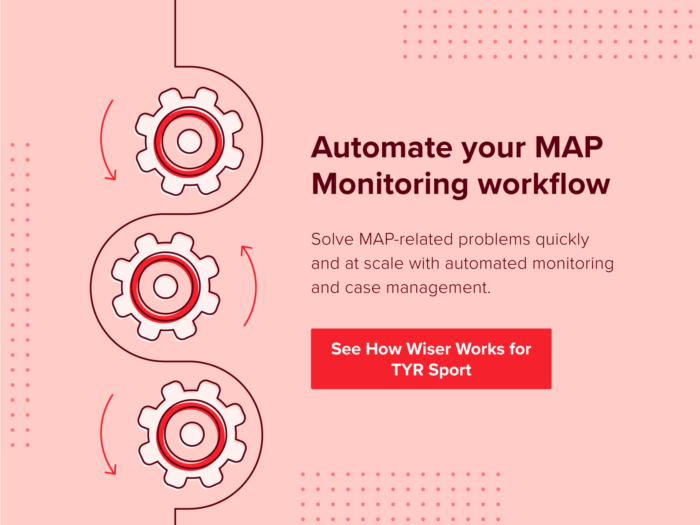Preismanagement. Klingt lustig, oder? Unabhängig von Ihrem Fachwissen und Ihrer Erfahrung im Bereich der Preisgestaltung (vielleicht sind Sie ja ein Analyst, für den sich Preismanagement tatsächlich nach Spaß anhört) ist die Festlegung des richtigen Preises für ein Produkt, das Ihr Unternehmen von Grund auf neu entwickelt, unglaublich wichtig.
Wirkt sich die Preisgestaltung wirklich auf Ihr Markenimage aus?
Die Preisgestaltung ist eine der wichtigsten Überlegungen für Kunden, wenn sie sich mit den Produkten Ihrer Marke befassen. Was sie vorfinden, kann ihre aktuellen und künftigen Käufe zum Guten oder Schlechten beeinflussen.
Es kann schwierig sein, die richtige Nische für die Preisgestaltung Ihrer Marke zu finden. Zu niedrige Preise können die Wahrnehmung Ihrer Marke durch die Verbraucher negativ beeinflussen, die sie als "billig" empfinden. Hohe Preise können Ihre Produkte als hochwertig und qualitativ hochwertig erscheinen lassen, aber wenn sie zu teuer sind, entgehen Ihnen die Gewinne von Menschen, die es sich nicht leisten können.
Die Preisgestaltung ist nicht das A und O für das Image Ihrer Marke, aber den richtigen Punkt zu finden, kann einen echten Wendepunkt darstellen.

Warum ist Markenschutz wichtig?
Preise wirken sich auf den Ruf der Marke aus und prägen alle Ihre Beziehungen zu den Einzelhandelspartnern. Natürlich ist der Preis auch ein zentraler Faktor für jede Kaufentscheidung der Verbraucher und kann über Erfolg oder Misserfolg eines Produkts entscheiden. Sie wollen also, dass der Preis den Wert Ihrer Marke steigert, aber Sie wollen die Einzelhändler nicht vom Verkauf Ihrer Produkte abhalten, wenn Ihre Preisstrategien unrealistisch sind.
Halten Sie Ihre Preisgestaltung flexibel
Dies ist ein Tipp für alle Start-ups, aufstrebende Marken und neue Produkteinführungen: Eure Preise sollten nicht gleich bleiben!
Es ist einfach, eine Preispolitik für ein neues Produkt oder eine neue Dienstleistung festzulegen und sie dann zu vergessen, vor allem, wenn Sie zu Beginn hohe Umsatzerlöse erzielen. Dies kann jedoch später problematisch werden, wenn Ihre Marke reift und Ihr Produkt Marktanteile gewinnt. Der anfängliche Preis ist möglicherweise nicht der richtige Preis für eine etablierte Marke, ein beliebtes Produkt oder als Reaktion auf neue Wettbewerber.
Aus diesem Grund müssen Sie bei Ihren Preisstrategien flexibel sein, um Ihre Marke zu schützen. Wenn Ihre Marke altert, müssen Sie dafür sorgen, dass Ihre Preise dem Wert Ihrer Marke entsprechen. Denn in dieser wettbewerbsintensiven Einzelhandelslandschaft ist es schwer, Ihre Marke zu schützen. Wiederverkäufer senken ständig die Preise, um Verkäufe zu erzielen. Sie müssen also Preisstrategien entwickeln, um Ihre Marke vor einem ausufernden Preiskampf zu schützen.
Konzentrieren Sie sich auf die Erstellung von Preisrichtlinien für jede Phase Ihres Produktlebenszyklus und bleiben Sie auf dem Laufenden über Wettbewerbs- und Markttrends, um fundierte Entscheidungen über die Zukunft Ihrer Produkte - und Ihrer Marke - zu treffen.
Wählen Sie Ihre Politik: UPP und MAP
Wenn es um Markenschutz und Preisgestaltung geht, fallen einem sofort zwei Maßnahmen ein: Die einseitige Preispolitik (UPP) und die Politik der beworbenen Mindestpreise (MAP).
Beim UPP geht es darum, dass die Marke den Preis für ein Produkt festlegt und die Wiederverkäufer daran hindert, diesen Preis in irgendeiner Weise anzupassen - sei es durch Preisnachlässe, Anreize, Rabatte oder Ähnliches - und diese Preise einseitig und ohne Mitwirkung der Einzelhändler zu ändern. MAP ist eine Vereinbarung zwischen Marke und Einzelhändler, ein Produkt nur zu einem bestimmten Preis oder darüber zu bewerben. Ob es zu diesem Preis oder darüber verkauft wird, steht auf einem anderen Blatt, und dies gibt den Wiederverkäufern die Flexibilität, ein Produkt zu einem niedrigeren Preis anzubieten, wenn sie dies wünschen.
Beide Arten von Richtlinien stellen sicher, dass Ihre Waren zu einem Preis verkauft werden, mit dem Ihre Marke einverstanden ist, und schützen Ihr Image, indem sie eine einheitliche Front für alle Verkäufer bilden.
Befolgen Sie diese Schritte bei Ihrer Preispolitik
Unabhängig davon, ob Sie sich für UPP oder MAP entscheiden, gibt es einige Schritte, die Sie bei der Ausarbeitung einer Richtlinie und deren Einführung bei Ihren Wiederverkäufern beachten sollten. Zu diesen Schritten gehören Planung, Implementierung, Überwachung und Durchsetzung.
Planung
Ein großer Teil der Arbeit hängt von der Branche und der Art der Marke ab. Eine preiswerte Marke wird zum Beispiel nicht immer dieselbe Strategie verfolgen wollen wie eine Luxusmarke. Bevor Sie Ihre Preisflexibilität verstehen, müssen Sie Ihre Nachfrageelastizität kennen. Wenn Sie wissen, wie die Verbraucher auf Ihre Preisänderungen reagieren, können Sie Ihre Preise in Zukunft optimieren. Dies wird zu einer starken Preisstrategie führen, die Ihre Marke schützen wird.
Umsetzung von
Vergewissern Sie sich, dass Sie die Richtlinien schriftlich festgehalten und allen Wiederverkäufern gleichermaßen mitgeteilt haben - bevorzugen Sie nicht einen Einzelhändler gegenüber einem anderen. Jetzt ist auch ein guter Zeitpunkt, um juristische Hilfe in Anspruch zu nehmen, um sicherzustellen, dass Ihre Richtlinien nicht gegen das Gesetz verstoßen. Es ist ratsam, eine Person oder ein Team in Ihrem Unternehmen zu benennen, die bzw. das sich um all diese Fragen kümmert, denn Sie wollen nicht, dass Missverständnisse zu Problemen bei der Umsetzung führen. Engagierte Beteiligte, die schriftliche Fixierung der Richtlinien, die Konsultation der Rechtsabteilung und die gemeinsame Nutzung der Richtlinien tragen wesentlich zu einer reibungslosen Umsetzung bei.
Überwachung und Durchsetzung
Jetzt ist ein guter Zeitpunkt, um sich über Lösungsanbieter (wie Wiser Solutions und unsere Brand Intelligence Solution) zu informieren, die Ihnen helfen können, Preise und Marktbedingungen über Ihre Online- und Ladenkanäle hinweg zu verfolgen. Leider verstoßen Einzelhändler häufig gegen Preisrichtlinien, und diese Verstöße können dem Image Ihrer Marke sehr schaden. Die Software kann Ihnen helfen, Ihr gesamtes Händlernetz im Auge zu behalten. Eine automatische Überwachung kann Sie warnen, sobald gegen Ihre Preispolitik verstoßen wird, und von dort aus können Sie Maßnahmen ergreifen, um sicherzustellen, dass die Wiederverkäufer nicht noch einmal dagegen verstoßen.

Versuchen Sie ein paar markenorientierte Preisstrategien
Und schließlich können bestimmte Preisstrategien aus Sicht des Markenschutzes besser sein als andere. So kann beispielsweise ein täglicher Niedrigpreis für eine Discountmarke genau richtig sein, für eine Luxusmarke jedoch nicht. Nicht jede Preisstrategie passt zu jeder Marke.
Hier sind zwei, die Ihnen helfen können, Ihr Markenimage zu schützen:
Nr. 1 Marktdurchdringung Preisgestaltung
Marktdurchdringungspreise sind eine Strategie, bei der ein Hersteller einen Artikel zu einem Preis einführt, der relativ niedriger ist als der der Konkurrenz. Auf diese Weise können Sie bei der Einführung die Aufmerksamkeit auf Ihre Marke lenken. Es ist nützlich für Marken, die eine Präsenz mit hohem Verkaufsvolumen aufbauen wollen. Sobald Sie Ihr gewünschtes Verkaufsvolumen erreicht haben, können Sie den Preis Ihres Artikels im Laufe der Zeit langsam erhöhen, um die Margen, die Sie bei der Einführung verloren haben, wieder auszugleichen.
Diese Strategie ist nützlich für Marken, die mit ihren Preisen einen Wert vermitteln wollen. Sie kann Ihnen helfen, als eine Marke bekannt zu werden, die billiger ist als der Rest, und der niedrige Preis wird Ihnen helfen, bei den Verbrauchern eine Menge an Zugkraft zu gewinnen. Allerdings müssen Sie sich eine Zeit lang von den Preisen der Wettbewerber absetzen, bevor Sie Ihre Preise wieder erhöhen können. Es ist nach wie vor wichtig, eine eigene Wertidentität zu besitzen, um Kunden und Einzelhändler an sich zu binden.
Markenschutz kann viele Formen annehmen, aber Ihre Preisgestaltung sollte immer dazu beitragen, Ihre Marke so zu präsentieren, wie Sie es wünschen und wie Sie von Ihren Kunden gesehen werden müssen.
Nr. 2 Marktabschöpfende Preisgestaltung
DiePreisgestaltung bei der Marktabschöpfung ist sozusagen das Gegenteil der Marktdurchdringung. Wenn eine Marke Marktabschöpfung betreibt, setzt sie den Preis für ihre Produkte auf den höchsten Anfangspreis fest, den die Verbraucher zahlen würden. Von dort aus werden die Preise im Laufe der Zeit langsam gesenkt, um Kunden anzuziehen, die nicht bereit sind, den höchsten Preis zu zahlen.
Diese Strategie kann für eine Marke nützlich sein, die ein luxuriöses Markenimage aufbauen möchte. Sie wird auch in einer Vertikale gut funktionieren, die generell hohe Preise verlangt, so dass Sie nicht wie ein wunder Daumen herausstechen werden. Und wenn Sie preisbewusstere Verbraucher ansprechen wollen, können Sie Ihren Preis mit der Zeit senken. Wenn Sie jedoch an der Spitze Ihrer Preisspanne bleiben möchten, gibt es Möglichkeiten, um sicherzustellen, dass Sie diese Markenidentität beibehalten.
Der Preis hat einen großen Einfluss auf Kaufentscheidungen, und da die Einzelhändler jeden Tag versuchen, wettbewerbsfähig zu bleiben, senken sie die Preise. Das kann Ihrer Marke schaden, vor allem wenn Sie wollen, dass der Preis Ihren Wert beeinflusst. Die Entwicklung einer strategischen Preispolitik kann definitiv helfen.
Markenschutz kann viele Formen annehmen, aber Ihre Preisgestaltung sollte immer dazu beitragen, Ihre Marke so zu präsentieren, wie Sie es wünschen und wie Sie von Ihren Kunden gesehen werden müssen.
Anmerkung der Redaktion: Die Autoren sind Brian Smyth, Matt Ellsworth und Alexandria Flores. Dieser Beitrag wurde ursprünglich im Oktober 2015 veröffentlicht und wurde seitdem aktualisiert und aufbereitet, um die Lesbarkeit und Genauigkeit zu verbessern.















